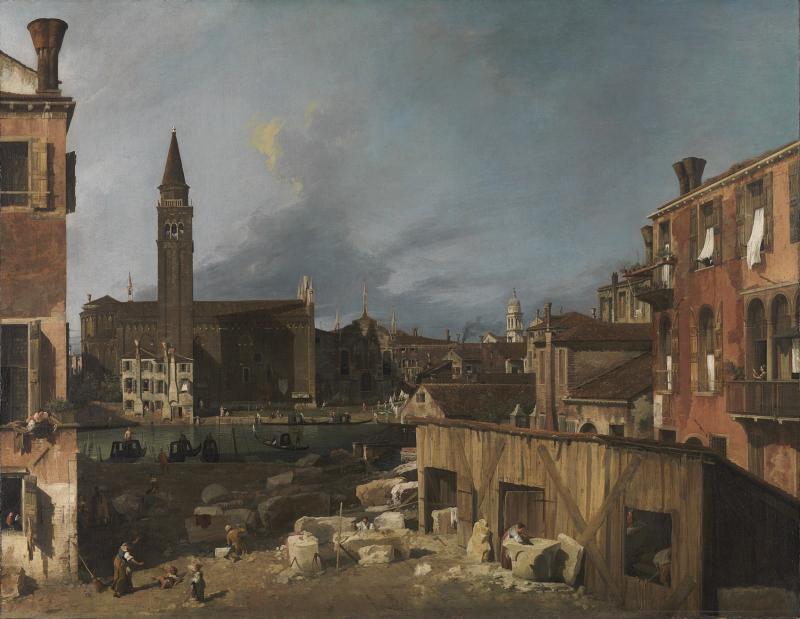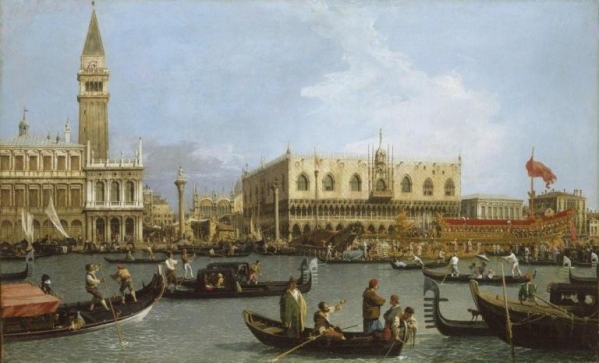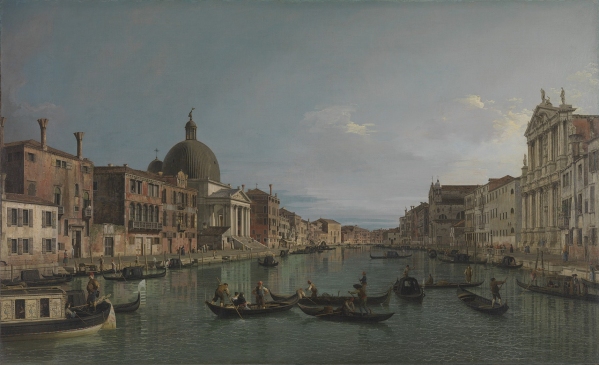Venice: Canaletto and His Rivals, National Gallery | reviews, news & interviews
Venice: Canaletto and His Rivals, National Gallery
Venice: Canaletto and His Rivals, National Gallery
The Venetian master seen afresh

People love Canaletto, and the title of this exhibition - which puts the setting of the paintings above the artist who did them - gives a good idea why. Venice as a place and an idea is perennially popular, and Canaletto gives us the big views – the Doge’s Palace, the Grand Canal, the Rialto – in painstakingly literal detail.
A walk through the first rooms of this substantial exhibition does little to dispel the impression that if you’ve seen two or three Canalettos you’ve seen them all. If the Venetian preoccupation with light and colour was inspired by the constantly changing atmospheric conditions over the lagoon, the light in Canaletto's paintings seems always the same: slightly golden on those immemorial canal fronts, the sky a perrennial, faintly greenish eggshell blue. The focus is sharp, the distance long, with people plonked about like those tiny plastic figures used in architects' models – and with about the same degree of human interest.
When the contrast knob is twisted a notch, throwing deep shadows across the foregrounds, and enriching the colour, the painting generally turns out to be the work of Canaletto’s pupil, Bernardo Belotto.
Yet while there are some spectacularly boring paintings in this exhibition, the experience over all is far from uninteresting.
The opening painting, San Christophoro, San Michele and Murano, its central buildings highlighted against swirling sky and dark water, has a tenebrous, Gothic quality worthy of Salvator Rosa. The early landmark The Stonemason’s Yard – painted in 1725, when the artist was 28 – is a fantastic work, the richness of the late-afternoon light giving the scene a marvellous, moody solidity, while the people working in the yard feel properly observed.
Yet by the time of the small Entrance to the Grand Canal, four years later, Canaletto’s mature style was already fully formed, the precision of the sense of space and opalescent light giving it the look of some illusionistic box, into which the identikit gondoliers have been dropped to give a sense of depth. Superbly skilled, it feels a touch contrived and clinical. From there on his approach is refined, but seems barely to develop. And that's hardly surprising given his spectacular success with British and Irish visitors to Venice, which gave rise to a whole school of imitators.
Some, such as Michele Marieschi and Canaletto’s nephew Bernardo Belotto, are almost as good as Canaletto himself. Marieschi’s The Rialto Bridge from the Rio del Vin, with its ominous sky, has a romantic, tumbledown quality that looks forward to Francesco Guardi, the last real Venetian master, later in the 18th century. Others, like Antonio Joli and Luca Carlevarijs (who slightly predated Canaletto), are so dull they throw Canaletto's own qualities into stark relief, revealing him as far more than a pedestrian imitator of reality.

Where Carlevarijs’s depictions of ceremonials at San Marco simply pile on the anecdotal detail – the crowds of onlookers, the jostling barges and boatmen – to no real pictorial effect, Canaletto’s The Bacino di San Marco on Ascension Day (pictured above) uses the movements of the gondoliers to enhance the powerful rightward sweep of the composition.
If conversations overheard in this exhibition tend to be about the places depicted as much as the way they’ve been depicted ("Isn't that the alley we went down last time we were there?"), that is in a way appropriate. On one level, Canaletto’s paintings represent the triumph of old-fashioned "this is the way things look" verisimilitude. Glimpsing a masked figure in the cabin of a gondola, we are weirdly persuaded that person is there. Yet they also do a great deal more than that.

Looking into a painting such as The Grand Canal with San Simeone Piccolo and the Scalzi (pictured above), with its pattern of gondolas defining the reflected light on the central expanse of water, we are looking into a hyper-real Venice of the mind that exists at a tangent to the physical city. This is one of a number of views the artist returned to again and again - doubtless principally for commercial reasons - which, through being endlessly reperceived, achieve an internalisation and abstraction that carries them far beyond the quotidian view. Far from being bland, the best of Canaletto's paintings have a cool, mesmeric intensity that over-familiarity has made it difficult to perceive. But go to this exhibition, give it some time, and you'll discover another Canaletto who exists way beyond the dentist's waiting room.
- Venice: Canaletto and His Rivals is at the National Gallery until 16 January, 2011
Explore topics
Share this article
The future of Arts Journalism
You can stop theartsdesk.com closing!
We urgently need financing to survive. Our fundraising drive has thus far raised £33,000 but we need to reach £100,000 or we will be forced to close. Please contribute here: https://gofund.me/c3f6033d
And if you can forward this information to anyone who might assist, we’d be grateful.

Subscribe to theartsdesk.com
Thank you for continuing to read our work on theartsdesk.com. For unlimited access to every article in its entirety, including our archive of more than 15,000 pieces, we're asking for £5 per month or £40 per year. We feel it's a very good deal, and hope you do too.
To take a subscription now simply click here.
And if you're looking for that extra gift for a friend or family member, why not treat them to a theartsdesk.com gift subscription?
more Visual arts
 Help to give theartsdesk a future!
Support our GoFundMe appeal
Help to give theartsdesk a future!
Support our GoFundMe appeal
 Echoes: Stone Circles, Community and Heritage, Stonehenge Visitor Centre review - young photographers explore ancient resonances
The ancient monument opens its first exhibition of new photography
Echoes: Stone Circles, Community and Heritage, Stonehenge Visitor Centre review - young photographers explore ancient resonances
The ancient monument opens its first exhibition of new photography
 Hylozoic/Desires: Salt Cosmologies, Somerset House and The Hedge of Halomancy, Tate Britain review - the power of white powder
A strong message diluted by space and time
Hylozoic/Desires: Salt Cosmologies, Somerset House and The Hedge of Halomancy, Tate Britain review - the power of white powder
A strong message diluted by space and time
 Mickalene Thomas, All About Love, Hayward Gallery review - all that glitters
The shock of the glue: rhinestones to the ready
Mickalene Thomas, All About Love, Hayward Gallery review - all that glitters
The shock of the glue: rhinestones to the ready
 Interview: Polar photographer Sebastian Copeland talks about the dramatic changes in the Arctic
An ominous shift has come with dark patches appearing on the Greenland ice sheet
Interview: Polar photographer Sebastian Copeland talks about the dramatic changes in the Arctic
An ominous shift has come with dark patches appearing on the Greenland ice sheet
 Donald Rodney: Visceral Canker, Whitechapel Gallery review - absence made powerfully present
Illness as a drive to creativity
Donald Rodney: Visceral Canker, Whitechapel Gallery review - absence made powerfully present
Illness as a drive to creativity
 Noah Davis, Barbican review - the ordinary made strangely compelling
A voice from the margins
Noah Davis, Barbican review - the ordinary made strangely compelling
A voice from the margins
 Best of 2024: Visual Arts
A great year for women artists
Best of 2024: Visual Arts
A great year for women artists
 Electric Dreams: Art and Technology Before the Internet, Tate Modern review - an exhaustive and exhausting show
Flashing lights, beeps and buzzes are diverting, but quickly pall
Electric Dreams: Art and Technology Before the Internet, Tate Modern review - an exhaustive and exhausting show
Flashing lights, beeps and buzzes are diverting, but quickly pall
 ARK: United States V by Laurie Anderson, Aviva Studios, Manchester review - a vessel for the thoughts and imaginings of a lifetime
Despite anticipating disaster, this mesmerising voyage is full of hope
ARK: United States V by Laurie Anderson, Aviva Studios, Manchester review - a vessel for the thoughts and imaginings of a lifetime
Despite anticipating disaster, this mesmerising voyage is full of hope
 Lygia Clark: The I and the You, Sonia Boyce: An Awkward Relation, Whitechapel Gallery review - breaking boundaries
Two artists, 50 years apart, invite audience participation
Lygia Clark: The I and the You, Sonia Boyce: An Awkward Relation, Whitechapel Gallery review - breaking boundaries
Two artists, 50 years apart, invite audience participation

Add comment